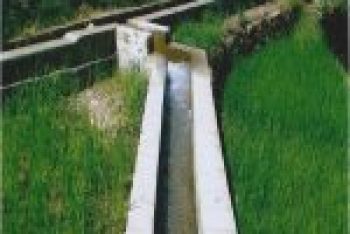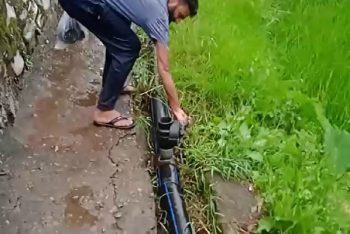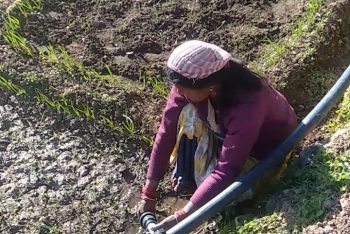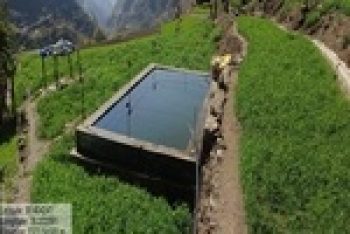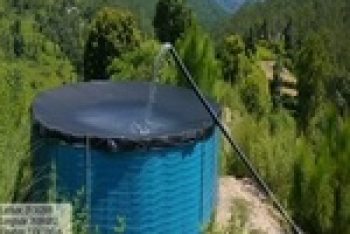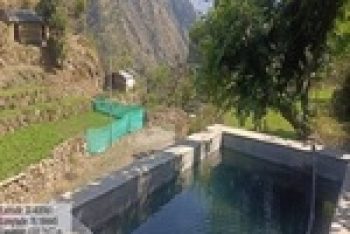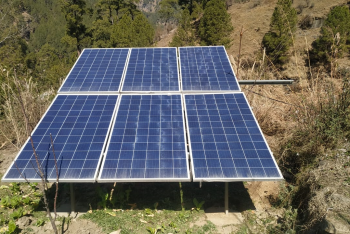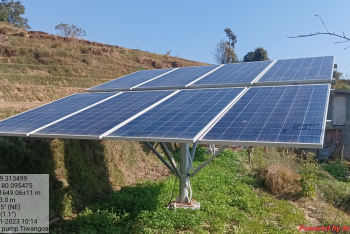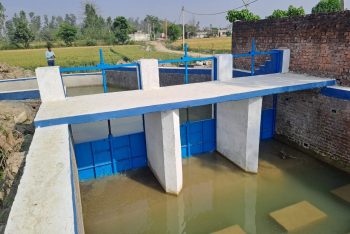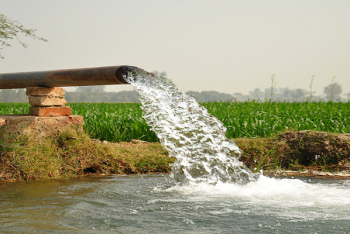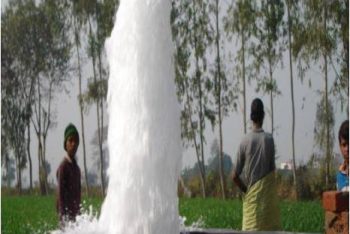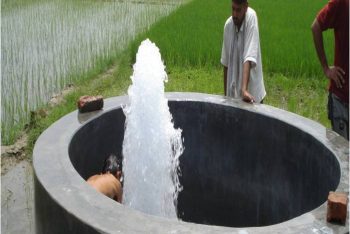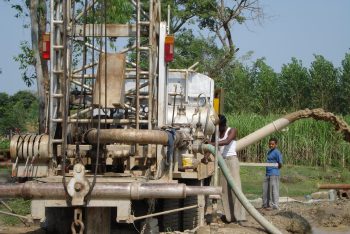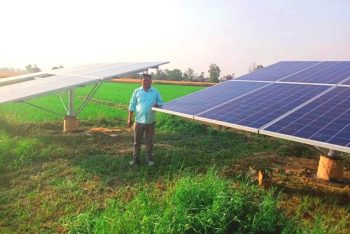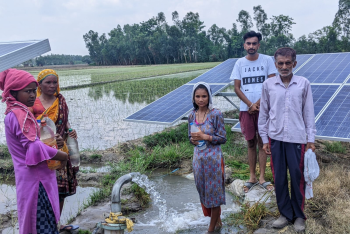2. Construction of irrigation tank:-
When the availability of water at a source is generally less, and agricultural land is available near it or at some distance, then a concrete irrigation tank/water line tank is constructed for the purpose of providing irrigation facility to that agricultural land. These irrigation tanks are constructed in different sizes and types to provide irrigation facility to the agricultural lands of groups of villagers keeping in view the condition of the area. The tank is designed in such a way that it gets completely filled within 12 to 24 hours with water taken from the available water source, so that farmers can use it to irrigate their fields in turns. Water/water line from the source can be connected to the tank through pipes as per the availability of water. The cooperation of the villagers is also taken in the construction of these tanks, so that their proper maintenance can be ensured in future.
3. Solar Pump Lift Irrigation Scheme (Mountainous Area):
In the mountainous areas of the state, agricultural land located at high altitudes where it is not possible to provide irrigation facility through any other means, irrigation facility can be provided to unirrigated agricultural land located at a higher altitude than the water source through solar power pumpset.
Advantages of Solar Pumpset:
- Solar operated pump can work from sunrise to sunset.
- Due to no money being spent on operation, the expenditure on irrigation is reduced and due to low input cost, the agricultural income of farmers increases and their economic status improves.
- The life of a solar panel is about 25 years and that of a pump is 08 to 10 years.
- Being operated by alternative energy, dependence on diesel and electricity ends.
- On the scheme Micro irrigation system (drip/sprinkler/raingun etc.) can be operated easily.
- It helps in reducing carbon emissions from fossil fuels and is environment friendly.
- It is possible to transport water to a higher height as compared to diesel.
3. Hydram installation:
There is no use of diesel engine or electricity etc. in irrigation through hydram. In mountainous areas, natural flowing rivers, streams, ponds and waterfalls are the main means of irrigation. Transporting water from these natural sources to fields located at higher altitudes is a difficult problem. Due to this, in hilly areas, despite having more water than plain areas, only five percent of the land is irrigated. Water is lifted from rivers, streams, waterfalls and ponds situated below the surface and transported to the fields through hydram.
The following things are necessary for the selection of site for construction of hydram scheme:-
- The required quantity of water should always be available in the river or stream.
- The required drop (cutwach) should be available for the hydram machine.
- The place where the hydram is installed should be safe from floods.
The efficiency of the hydram depends on the available water quantity and the height of carrying the water. When the drop is more, the discharge also increases and when the height increases, the discharge decreases. At present, the department is using Sol instead of hydram scheme for irrigation of land situated at higher altitudes.
4. Weir (small barrage):
Places where there are natural perennial sources (chamatmadpasamp vanatabam), irrigation is available by stopping their water and raising its level, but raising its level permanently creates the problem of water logging in the rainy season for the fields above. To deal with this, a gated structure is required. This scheme has proved useful in the Terai and Bhabar regions of Uttarakhand.
B – Groundwater based irrigation means:
Due to changes in the geological structure in different areas, keeping in view the groundwater sources and means, different types of constructions are made according to the possibility of a particular area. Water is lifted by installing electric motor or diesel pump set on small-large perennial drains or ponds based on surface water and the fields are directly irrigated. These are mainly of the following types:-
1. Tubewell
Tubewell is a means of water extraction in which water is extracted from the ground through a pipe. Diesel pumpset or electric motor is used to lift water. A concrete hut (room), a concrete delivery tank and a slightly concrete canal are the essential components of a tube well.
Tube wells are divided into two categories based on the depth of their boring:
- Deep tube wells – whose depth is 100 meters or more.
- Shallow tube wells – whose depth is less than 100 meters.
The cost of irrigation from private tube well/boring is less as compared to other means of irrigation. The tube well is completed at a low cost and in a short period and can be repaired immediately in case of breakdown. It does not have any adverse effect on the environment.
2. Artesian Well
Artesian well is a water source in which high pressure water flows between confined and unconfined water layers. When a pipe is inserted by drilling in these layers, the hydraulic pressure of the fluid is so high that the water automatically starts coming out of the tube well in the form of a spring upwards in the opposite direction of gravity. The amount of water flow depends on the pressure and condition of the water available in that area. Once the artesian well is successfully drilled, the water starts flowing automatically, and the availability of water remains constant.
This type of well does not require any external energy source (such as diesel pump or electric motor) to draw water. Therefore, except for its installation cost, no additional expenditure is required for its operation. Construction of artesian well provides free irrigation facility to farmers, which reduces the expenditure on irrigation. This reduces the input cost of their crops and increases their income. Mainly some areas of Udham Singh Nagar district and Nainital, such as Rudrapur, Sitarganj, Gadarpur, Bajpur, Kashipur and Ramnagar etc. are considered suitable for setting up artesian wells.
3. Irrigation Scheme with Solar Boring Pumpset (Plain Area)
In the plain districts of the state, diesel and electric pumpsets are often used for irrigation. Due to excessive expenditure on diesel and electricity, the production cost increases.
In order to reduce the cost of irrigation, the department is installing solar pumpsets under various heads, so that the production cost of farmers is reduced and their income can increase.
Advantages of Solar Pumpset:
- Solar powered pump can work from sunrise to sunset.
- Due to no money being spent in operation, the cost of irrigation is greatly reduced. This reduces the input cost and increases the agricultural income of the farmers, thereby improving their economic condition.
- The life of a solar panel is about 25 years and that of a pump is 8 to 10 years.
- Being operated from an alternative energy source, the dependence on diesel and electricity ends.
- Under this scheme, micro irrigation systems (drip/sprinkler/raingun etc.) can be easily operated.
- It helps in reducing carbon emissions from biofuel and is also environment friendly.
Pradhan Mantri Kisan Urja Suraksha Evam Utthan Mahabhiyan (PM-KUSUM) has been launched by the Government of India in the year 2019. The objective of this scheme is to make the agriculture sector diesel-free, increase the income of farmers, give them energy security and promote the use of solar energy. Under Component-B of this scheme, diesel pumps used in agricultural work are being converted into solar pumps, so that farmers are not dependent on diesel or electricity for irrigation.



